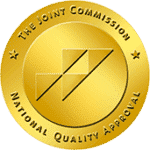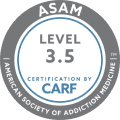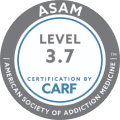Methamphetamine Treatment
As reported by the Center for Disease Control and Prevention, over 1.6 million people admitted to using the drug in the previous year. Over 51% admitted to having a methamphetamine addiction, now known as a methamphetamine use disorder.
It doesn’t take long to develop a methamphetamine use disorder due to how the drug interacts with the brain and central nervous system. However, treatment has been shown to be effective and long lasting. Read on to learn more about how to find support.

Methamphetamine Addiction
Meth is a potent stimulant that, when consumed:
- Increases heart rate
- Increases body temperature
- Raises blood pressure
- Increases respiration
- Is energizing
- Improves focus
Meth also signals a release of dopamine neurotransmitters in the brain. Dopamine is the chemical associated with reward. When flooded with meth, a high level of dopamine is released, providing a euphoric high.
The crash on meth can be severe, which is why many continue using it. They become physically dependent on the drug. Eventually, the brain becomes convinced it cannot survive without meth. They become addicted and will do whatever it takes to avoid withdrawal symptoms.
For most, it is too difficult to quit using meth alone. Help from treatment professionals is needed.
Treatment for Methamphetamine Use Disorder
Before healing of the mind and body can begin, meth must be flushed the body. Entering in a detox program is the safest and most comfortable way to do this.
Detox Program
Detox is a medically supervised program in an inpatient setting, which provides 24-hour medical care. Our staff effectively treats withdrawal symptoms to ensure the highest level of comfort. For example, if the patient has trouble sleeping, our doctor can prescribe appropriate medications to help.
Once the body has been detoxed from drugs, the mind is clearer, and it becomes easier to focus on learning new recovery skills in inpatient rehab.
Inpatient Rehab
Just because the body is free of meth doesn’t mean the mind won’t continue to have intense cravings and urges to use again. This is one reason many choose to stay in treatment after detox to gain tools to help prevent relapse when they return home.
Inpatient rehab is a structured program in a medical setting with continued supervised medical care and therapeutic activities. Inpatient rehab stays range from a couple of days to a month; studies suggest that longer stays in treatment equate to higher success rates.
Inpatient rehab treatment models are varied and chosen based on an evaluation by a therapist and medical staff who create an individualized treatment plan.
Common Forms of Treatment
Individual Counseling involves meeting one-on-one with a therapist to discuss treatment progress, set goals, and engage in learning activities. Therapists may use evidence-based treatment models like the following:
Cognitive-behavioral therapy is a form of talk therapy based on the theory that thoughts lead to feelings and behaviors. Negative thoughts lead to negative behaviors. Changing thoughts from negative to positive can help change behaviors that can cause relapse on meth.
Contingency management therapy is a treatment in which incentives are provided for remaining sober. It’s a form of behavior modification intervention.
Motivational enhancement therapy is a process that helps them overcome doubts and embrace recovery. Because not everyone enters treatment ready for change, this can be useful in that case.
Trauma-focused therapies are specific treatments for people who have post-traumatic stress disorder. One example is Trauma-focused Cognitive Behavior Therapy. Another is EMDR, or eye movement desensitization and reprocessing.
Dual diagnosis disorders are a combination of a substance use disorder and a mental health disorder. Dual diagnoses are common. Depression, anxiety, bipolar, eating disorders, and codependency are examples of mental health issues associated with meth and other drug use disorders. Dual diagnosis disorder treatment is crucial for recovery success.
Group therapy involves attending special meetings with peers. A mental health and addictions therapist leads groups. Groups focus on specific topics, like early recovery skills, relapse prevention skills, and coping with dual diagnoses.
Family therapy is extremely beneficial in the beginning stages of recovery. Addiction affects the whole family, and likely there are boundary and enabling issues to overcome before returning home. A licensed marriage and family counselor or addiction specialist will lead activities to teach the whole family how to heal.
Holistic or alternative treatments focus on healing the mind, body, and spirit. Because they are all connected, it’s essential to learn to pay attention to what the body needs and meet those needs. Examples of these treatments include meditation, yoga, spirituality, and acupuncture.
Upon completion of an inpatient program, outpatient treatment is almost always recommended. Many people need continued structure and treatment to enable a life of recovery and success. Returning home without an aftercare plan can make recovery more difficult.
Aftercare Plan
An aftercare plan consists of all the positive programs lined up upon returning home to enable success in recovery. Having an understanding of aftercare plans can benefit you or your loved one upon completing treatment.
Sober living homes offer a place to stay in between leaving rehab and returning home. It provides space and time to adjust to life outside of treatment.
Intensive Outpatient Program (IOP) is a structured program that gives individual, group, and family therapy for more than ten hours each week. Continued learning on relapse prevention, sober skills, and for some, medication management. The longer time spent in treatment, the less intensive services are needed. Eventually, meeting with an individual counselor occasionally for check-ins and ongoing support is all that may be necessary.
Before leaving treatment, it’s helpful to know about 12 Step and recovery support groups local to the area, along with days and times they meet. Attend a meeting the same day as being discharged from treatment. Attend as many support groups as possible in the month or two of returning home.
Early in recovery, many people need help finding a job, improving job-related skills, creating a resume, interviewing, and more. Vocational counseling sessions can be planned to help with these issues. Adjusting to a sober lifestyle can be overwhelming. A case manager will help the patient keep up with medical appointments, job interviews, counseling sessions, 12 Step and community support groups, and seek services for any new problems.
Achieving long-term recovery is possible. Completing the above steps increases the odds of success.
Long-Term Recovery
Methamphetamine is a dangerous drug that causes damage to the brain and body. Long-term recovery is a daily process that takes effort and care. Don’t give up. Continue to make efforts to overcome your methamphetamine use disorder.
Think of these treatment programs as armor against addiction. Each program represents another layer of armor, another barrier between you and addiction. Eventually, your armor will be so thick that nothing can cause you to relapse. You can start your recovery from meth today. Give us a call at (844) 933-4145 to find resources and support on your journey to recovery.
Verify Insurance
Let’s get you or a loved one help with a few simple steps.



